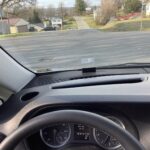It’s a common question among Tesla owners and those familiar with standard vehicle diagnostics: Does Tesla have an OBD2 port? The short answer is no, not in the traditional sense you might expect from gasoline-powered cars. However, accessing diagnostic data from your Tesla Model 3 or Model Y is still entirely possible, just through a slightly different method.
While you won’t find a standard OBD2 port readily accessible under the dashboard of a Tesla Model 3 or Model Y, these electric vehicles are equipped with a console connector located in the rear passenger area. This port serves a similar purpose to the OBD2 port in conventional cars, allowing access to vehicle data for diagnostics and monitoring. To interface with this Tesla-specific port using standard OBD2 tools, you’ll need a Tesla OBD2 adapter. This adapter acts as a bridge, converting the Tesla connector to the more universally recognized OBD2 interface.
To effectively read the data from your Tesla, you’ll not only need the adapter but also an OBD2 tool that is compatible with ELM327 or STN1110 protocols. Popular choices among Tesla owners include OBDLink LX or MX Bluetooth devices, known for their reliability and compatibility. These tools, combined with the correct adapter, allow you to tap into the wealth of information your Tesla generates.
It’s important to understand that Tesla’s advanced security system limits the extent of modifications or system “hacking” possible through this diagnostic port. Connecting an OBD2 tool to your Tesla primarily grants you read-only access to live vehicle data. This means you can monitor various parameters and gain insights into your car’s performance, but you won’t be able to alter critical vehicle functions.
To visualize and interpret the data retrieved from your Tesla’s diagnostic port, specialized mobile applications are essential. Two leading apps in the Tesla community are Scan My Tesla and TM-Spy. These apps, available for both Android and iOS, are designed specifically to decode and display Tesla’s data streams in a user-friendly format.
Scan My Tesla provides a comprehensive overview of your vehicle’s real-time statistics, including:
- Battery health metrics such as power, voltage, current, and temperatures.
- Drive unit performance data encompassing electric power, torque, horsepower, RPM, and temperatures.
- Battery lifespan statistics, capacity estimations, and mileage tracking.
- 12V system monitoring, including current, voltage, and temperature.
- Trip recording and statistics, with a focus on charging data.
- HVAC system controls and readings.
Bjørn Nyland, a well-known Tesla enthusiast, offers a live demonstration of the Scan My Tesla app in action, showcasing its capabilities and user interface.
TM-Spy offers a different perspective, focusing on detailed battery cell information and pack-level data:
- Individual cell voltages, providing granular insight into battery balance (for 84 or 96 cell configurations depending on battery size).
- Maximum, minimum, and delta cell voltage values to assess battery health and balance.
- Histogram visualizations to illustrate battery pack balancing.
- Readings from 16 pairs of battery pack temperature sensors (inlet/outlet coolant temperatures).
- Total battery voltage and current during driving and charging cycles.
- Pack capacity and remaining energy in kWh.
- Mileage accumulated on the current battery pack, useful for tracking battery swaps.
- Lifetime battery discharge and charge energy in kWh.
David Drives Electric has created a video demonstrating the TM-Spy app, highlighting its features and the depth of battery information it provides.
The functionality of these Tesla diagnostic apps is largely thanks to the dedicated Tesla Model 3 community. This community has diligently identified and cataloged the CAN bus IDs and data points within Tesla vehicles, making it possible to decode and interpret the raw data. Their collaborative efforts are documented in a publicly accessible Google Sheet, a testament to their contribution.
The Tesla Owners Online Forum serves as a valuable hub for information and discussions related to Tesla diagnostics and data access, further highlighting the community’s role.
In conclusion, while Tesla vehicles like the Model 3 and Model Y deviate from the standard OBD2 port, they still provide access to rich diagnostic data. By utilizing a Tesla OBD2 adapter and compatible tools, along with apps like Scan My Tesla and TM-Spy, owners can gain valuable insights into their vehicle’s performance and health, all thanks to the collaborative spirit of the Tesla community.
